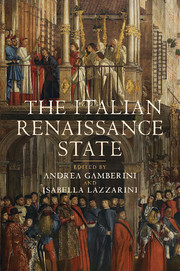Book contents
- Frontmatter
- Contents
- Notes on the contributors
- Note on translations and usage
- Map
- Introduction
- Part I The Italian states
- 1 The kingdom of Sicily
- 2 The kingdom of Naples
- 3 The kingdom of Sardinia and Corsica
- 4 The papal state
- 5 Tuscan states: Florence and Siena
- 6 Ferrara and Mantua
- 7 Venice and the Terraferma
- 8 Lombardy under the Visconti and the Sforza
- 9 The feudal principalities: the west (Monferrato, Saluzzo, Savoy and Savoy-Acaia)
- 10 The feudal principalities: the east (Trent, Bressanone/Brixen, Aquileia, Tyrol and Gorizia)
- 11 Genoa
- Part II Themes and perspectives
- Bibliography
- Index
3 - The kingdom of Sardinia and Corsica
Published online by Cambridge University Press: 05 August 2012
- Frontmatter
- Contents
- Notes on the contributors
- Note on translations and usage
- Map
- Introduction
- Part I The Italian states
- 1 The kingdom of Sicily
- 2 The kingdom of Naples
- 3 The kingdom of Sardinia and Corsica
- 4 The papal state
- 5 Tuscan states: Florence and Siena
- 6 Ferrara and Mantua
- 7 Venice and the Terraferma
- 8 Lombardy under the Visconti and the Sforza
- 9 The feudal principalities: the west (Monferrato, Saluzzo, Savoy and Savoy-Acaia)
- 10 The feudal principalities: the east (Trent, Bressanone/Brixen, Aquileia, Tyrol and Gorizia)
- 11 Genoa
- Part II Themes and perspectives
- Bibliography
- Index
Summary
Introduction
At the end of the thirteenth century the battle for commercial and political predominance over the western Mediterranean was more alive than ever before. The crown of Aragon had joined the two great rivals Genoa and Pisa in the contention for Sardinia and Corsica. Having gained possession of the Balearic islands and Sicily, it looked on the latter as an indispensible base for maritime expansion.
The battle also involved the papacy, as for centuries it had proclaimed the right of the church of Rome to dominium eminens (supreme dominion) over the three large Tyrrhenian islands. And it was indeed from the papacy, when it had seemed that Sicily, Sardinia and Corsica were finally released from its authority, that the initiative came that would place Sardinia, institutionally known as the kingdom of Sardinia and Corsica, inside the state framework of first the crown of Aragon (1324–1516) and then the crown of Spain.
The Trecento: the birth of the kingdom of Sardinia and Corsica
On 4 April 1297 pope Boniface VIII, in order to resolve diplomatically the war of the Vespers – which broke out in 1282 between the Angevin and Aragonese over possession of Sicily – instituted the hypothetical kingdom of Sardinia and Corsica and enfeoffed it to James II, sovereign of the crown of Aragon, in exchange for a feudal fee and pledge of loyalty. The concession of the kingdom was, in reality, a purely nominal act: the islands of Sardinia and Corsica were already politically and institutionally configured and as Casula writes, ‘in respect to them the pope gave only a licentia invadendi (right of conquest)’.
- Type
- Chapter
- Information
- The Italian Renaissance State , pp. 50 - 68Publisher: Cambridge University PressPrint publication year: 2012
- 1
- Cited by

